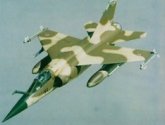
 During the
development of a successor for the Mirage
III/V series Dassault dropped the tailess delta configuration
for the conventional swept wing. The F1 first flew as a private
venture on the 23rd of December 1966, the F1 featured no great
technological advances over the Mirage
III but was considerably more capable with the Altar 9K-50
turbojet, a 43% increase in fuel, a doubling of the Mirage
III's attack radius, improved manoverability and 30% better
field performance. Production began in May 1973 with the F1C
but from 1977 production switched to the F1C-200 which featured
a fixed in-flight refuelling probe and a slight fuselage stretch.
Other variants included the recon F1CR with IR linescan and optical
cameras, two seat F1B, simplified attack optimized F1A, multirole
F1E and the F1D two seater.
During the
development of a successor for the Mirage
III/V series Dassault dropped the tailess delta configuration
for the conventional swept wing. The F1 first flew as a private
venture on the 23rd of December 1966, the F1 featured no great
technological advances over the Mirage
III but was considerably more capable with the Altar 9K-50
turbojet, a 43% increase in fuel, a doubling of the Mirage
III's attack radius, improved manoverability and 30% better
field performance. Production began in May 1973 with the F1C
but from 1977 production switched to the F1C-200 which featured
a fixed in-flight refuelling probe and a slight fuselage stretch.
Other variants included the recon F1CR with IR linescan and optical
cameras, two seat F1B, simplified attack optimized F1A, multirole
F1E and the F1D two seater.
Country of origin: France
Type: Multirole fighter
Powerplants: SNECMA Atar 9K-50 turbojet 15,875lb with afterburner
and 11,025lb dry
Max. speed: 2338km/h (1262kts)
Climb rate: 41,930ft/min
Ceiling: 65,600ft
Combat radius (14 550lb bombs) hi-lo-hi - 425km (230nm)
Weights: 7,400kg (16,315lb)
Max. Takeoff: 16,200kg (35,715lb)
Wing span: 27ft 7in (8.40m)
Length: 50ft 3in (15.30m)
Height: 14ft 9in (4.50m)
Wing area: 269.1sq. ft (25.0m2)
Crew: Pilot only; two in tandem in F1B and F1D
Armament: Two (fixed) DEFA 553 30mm cannons; 13,890lb (6,300kg)
on four underwing, one centreline and two wingtip hardpoints.
Weapons include Matra Magic or AIM-9 'Sidewinder', R.530, Super
R.530F AAM's, rockets, bombs, and ASM including AM-39 Exocet
and Armat anti radiation ASM's.